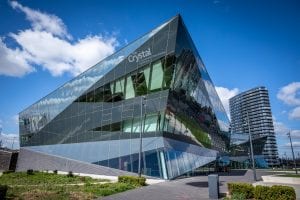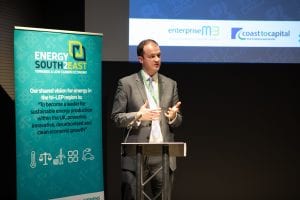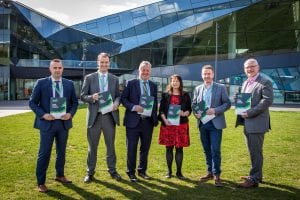Innovation and collaboration will bring forward new energy sources to cut carbon while accelerating clean growth in the economies of the South East. This was the message as a major energy strategy was put into action this week.
The South2East Local Energy Strategy, which will help meet statutory climate change targets for 2032 and 2050, was formally launched on March 25, at The Crystal, Royal Victoria Dock, London.
It has been drawn up by the South East Local Enterprise Partnership (SELEP), Coast to Capital and Enterprise M3 LEPs, in partnership with Siemens.
Area rich in natural assets

Carl Ennis, Managing Director, Siemens Energy Management, said: “The South East has the opportunity and the ability to lead in the low carbon economy, not just on a local level but as a beacon for the whole of the UK.”
He highlighted how the area is rich in natural assets, that new technology is becoming viable and key sectors are engaging, while challenges posed by grid constraints could be overcome by creating localised energy sources as emphasised in the strategy.
Region with global potential
Dave Axam, Chair, Enterprise M3, agreed the region has global potential.
“We can lead the world in this technology,” he said. “Enterprise M3 is a knowledge, digital and design -based economy. It is exactly the kind of economy which can turn these ideas into success not just in the UK but in the world. It’s not a decision between economic growth and a low carbon economy, we can do both.”
He praised the joint working that brought the Strategy together, saying: “It is all about partnership. This is a fantastic example of three LEPs pooling resources but it extends beyond LEPs, it’s a collaboration.
“This cannot be a document which gathers dust. We have to turn it into action for the transformation that needs to happen. And we need partnership for that to work.
“The step change we need to take is to call for more specific projects which are targeted towards delivering this strategy.”
Opportunity for business to grow

Adam Bryan, Managing Director, South East LEP, also emphasised the economic benefits of the Strategy, saying: “The low carbon supply chain is growing faster than the general economy. Investment in low carbon is not just good for the environment but makes commercial sense too, it is an opportunity for business growth as the 18 projects set out in the strategy highlight.”
He added: “Government at all levels will have a role to play in opening lines of funding, in supporting developing technologies through investment and partnerships with higher education institutions, and making changes to regulation and policy to support new technologies and its deployment to scale.
“Neither local nor national Government can drive innovation in the way that business can. Innovation requires risk-taking and entrepreneurship, so partnership across LEPs, the Government sector, directly between business and the public sector is needed.
“The Tri-LEP area has a strong track record in entrepreneurship and a network of universities with key strengths in research and development. With public sector support, I am confident, that innovators across the area will bring forward clean growth solutions.”
UK as world leader
Katherine Wright, Deputy Director, Public Sector and Local, BEIS, said: “I am delighted to be here, supporting three LEPs working together with businesses on ambitious, exciting plans and with an action plan, as we know these things have to be put into practice.”
She explained how the UK was a “world leader” on carbon reduction and was the first country to introduce legally-binding carbon reduction targets and that “we are decarbonising faster than any G20 country since 2020”. This would be 42 per cent by 2020 compared to 2010. In January, the Investing in Local Energy Strategy finance initiative was launched and to date, £7m has been invested in local energy hubs.
Two exemplary local projects were highlighted at the launch.
Chris Seamark, of EU-funded LoCASE (Low Carbon Across the South East), described how a grant of around £6m had been used to support more than 1,050 SMEs, cut emissions by 6,150 TCO2, as well as creating 270 new jobs and 77 new businesses. Projects included lights for an indoor bowling club and funding electrical black taxis. A new round of funding gets underway in July.
Tom Coates, of West Sussex County Council, explained how the council has two solar farms including the first non-commercial, subsidy-free farm in the UK, funded by the council through the Public Works Loan Board. Westhampnett Solar Farm, a former landfill site, is a 27, 665 panel, 7.44MW array, which is cutting carbon emissions by 20 per cent. Electricity is sold to generate income.
The county council has also led a schools solar PV programme with 75 installations and another for social housing tenants involving more than 220 residents, as well as an eco-funded heating programme supporting more than 500 vulnerable residents.
Tim Wates, Chair, Coast to Capital LEP, underpinned the fundamental importance of the strategy, saying: “It is a collaboration and we have formed something exceptionally meaningful. Clean growth is intrinsic in all that we do, it threads its way through the whole economy. It is the greatest economic opportunity of our time.”
The full strategy and action plan can be viewed at the following link: https://www.southeastlep.com/energysouth2east/
Editor’s Notes:
- The South2East Local Energy Strategy lists five priority themes for action:
low carbon heating;
renewable energy generation;
energy saving and efficiency;
smart energy systems;
and transport.
- It aims to secure £14.755 billion of commercially and technically viable projects and deliver a reduction in emissions across the electricity, heat and transport sectors of 13,615 kT CO2e, which is the equivalent of removing all five million cars in the south east from the road.
- Within the 5 priority themes, 18 key project models have been identified which can be rolled out and scaled up across the region and that will attract investment and achieve significant carbon emission savings. These include:
- supporting the development of district heat networks;
- connecting off-grid homes to gas supplies;
- hydrogen injection into the natural gas grid to lower the carbon content of gas;
- encouraging offshore wind development;
- developing solar arrays on council-owned landfill sites; and
- supporting the development of a biomass supply chain to use the South East’s natural resources.